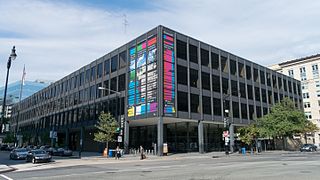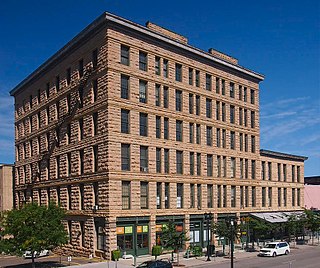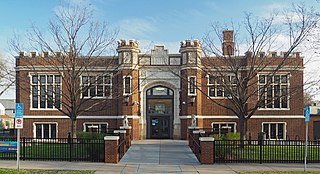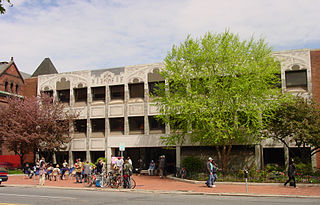
St. Lawrence University is a private liberal arts college in the village of Canton in St. Lawrence County, New York. It has roughly 2,400 undergraduate and 100 graduate students.

The Minneapolis Public Library (MPL) was a library system that served the residents of Minneapolis, Minnesota in the United States. It was founded in 1885 with the establishment of the Minneapolis Library Board by an amendment to the Minneapolis City Charter. Lumber baron and philanthropist T. B. Walker and other city leaders such as Thomas Lowry were members of the first library board. In 2008, after some financial difficulties, the library was merged into the Hennepin County Library system. At the time of its merger, the library included Central Library in downtown Minneapolis and fourteen branch libraries. Its collection numbered about 3.1 million items with about 2.2 million of these housed in the central library.

The Martin Luther King Jr. Memorial Library (MLKML) is the central facility of the District of Columbia Public Library (DCPL), it was constructed and named in honor of the American civil rights leader Dr. Martin Luther King Jr. It is located in the 901 G St. NW Downtown, with its main entrance between 9th and 10th St. in the opposite corner of Gallery Place station, and the Smithsonian American Art Museum, it serves also Chinatown, Washington, D.C., Mount Vernon Square and Penn Quarter neighborhoods.

Lake Superior College (LSC) is a public community college in Duluth, Minnesota. The college offers pre-baccalaureate majors for students interested in transferring to 4-year educational institutions as well as more than 90 certificate, diploma and degree programs in career and technical fields. LSC's Continuing Education/Customized Training division collaborates with area businesses and industry to design specialized opportunities for entry-level and advanced education. While courses are typically offered in traditional classroom and lab settings, LSC also offers over 150 courses via the internet, through its e-campus.

East Mississippi Community College (EMCC), formerly East Mississippi Junior College, is a public community college in Scooba, Mississippi. EMCC serves and is supported by Clay, Kemper, Lauderdale, Lowndes, Noxubee and Oktibbeha counties in east central Mississippi. The college has two principal campuses in Scooba and Mayhew, Mississippi and offers courses at five other locations. One of fifteen community colleges in Mississippi, EMCC is accredited by the Southern Association of Colleges and Schools Commission on Colleges (SACSCOC) to award the Associate of Applied Science degree and the Associate of Arts degree.

Minneapolis Community and Technical College is a public community college in Minneapolis, Minnesota. It has one of the most diverse student populations in the state and enrolls nearly 11,100 credit students annually. Minneapolis College is part of Minnesota State, which offers two-year associate degrees, certificates, and diplomas.

The Minneapolis Armory is a historic event center and former National Guard armory located in downtown Minneapolis, Minnesota, United States. Built by the Public Works Administration in 1936, the building was occupied by several Army and Naval Militia units of the Minnesota National Guard from its opening until 1985. The building is listed on the National Register of Historic Places.

The Twin Lakes Library System is a single-county public library system that serves the citizens of Milledgeville and Baldwin County, Georgia with two facilities.

Northampton Community College is a public community college in Pennsylvania with campuses in Bethlehem in Northampton County and Tannersville in Monroe County. The college, founded in 1967, also has satellite locations in the south side of Bethlehem and Hawley. The college serves more than 34,000 students a year in credit and non-credit programs.

The Traffic Zone Center for Visual Art (TZCVA) is an artist cooperative located in the historic Warehouse District of downtown Minneapolis, Minnesota, United States. Founded in 1993, TZCVA was established to create an artist-owned and managed building that provides stable, safe, and affordable studio, teaching and exhibition space for mid-career visual artists. TZCVA is a partnership between Artspace Projects, Inc., a leading national non-profit real estate developer for the arts, and a cooperative of 23 artist-members.

Roosevelt Library is one of 41 community libraries in the Hennepin County Library System, originally part of the Minneapolis Public Library System as it is located in Minneapolis, Minnesota, United States.

Sumner Library is a neighborhood library located in the Near-north neighborhood of Minneapolis, Minnesota, United States. Originally part of the Minneapolis Public Library, it became part of the merged Hennepin County Library in 2008. The Carnegie Library was a haven for Jewish immigrants to the city in the early 20th century. The Minneapolis Public Library moved its entire collection of Yiddish and Hebrew works to the branch library in response to a survey showing that 95% of the patrons were Jewish immigrants, some of whom learned English there and participated in social clubs in the building. The Tudor Revival building is listed on the National Register of Historic Places.

The Hubbard School of Journalism and Mass Communication is a journalism school at the University of Minnesota that offers programs in journalism, strategic communication and mass communication. It is located on the Minneapolis campus. It houses around 800 undergraduates and more than 30 graduate students in a given academic year.

Franklin Library is a public library on Franklin Avenue in Minneapolis, Minnesota, United States. The library was one of thirteen branch libraries established under the leadership of Gratia Countryman, the chief librarian of the Minneapolis Public Library from 1904 to 1936. The library housed the largest collection of Scandinavian books, newspapers, and magazines within the system, which reflected the population living in the area. The library was funded by the Carnegie Corporation and designed by Edward Lippincott Tilton, a New York City architect.

Linden Hills Library is a public library in the Linden Hills neighborhood of southwest Minneapolis, Minnesota, United States. The branch library originally opened in 1911 on the first floor of the Lake Harriet Commercial Club building. In 1931, under the leadership of Minneapolis Public Library's chief librarian Gratia Countryman, the library moved into its own building on 2900 West 43rd Street. Area resident Joseph Victor Vanderbilt designed the library in the Tudor Revival style. Head librarian Edith Frost served for over thirty years. The library has also hosted community groups such as children's clubs, neighborhood groups, and women's organizations. The library was listed on the National Register of Historic Places in 2000 and renovated in 2002.

Hosmer Library, originally known as the Thirty-Sixth Street Branch Library, is a branch library of the Hennepin County Library system serving the Central neighborhood of Minneapolis, Minnesota, United States. It was named the Hosmer Library in honor of James Kendall Hosmer and was listed on the National Register of Historic Places in 2000.

Walker Library is a public library in the East Isles neighborhood of Minneapolis, Minnesota, United States. It is on Hennepin Avenue one block north of Lake Street, adjoining the Midtown Greenway.
North Regional Library is a public library in Minneapolis, Minnesota, United States. It is part of the Hennepin County Library system. Since opening in 1971, North Regional Library at 1315 Lowry Ave. N. in Minneapolis serves a diverse metropolitan community, Near North, Minneapolis.

Albany Public Library (APL) is a public library system serving the city of Albany, New York. APL also operates as the Central Library for the Upper Hudson Library System, a resource sharing consortium which unites public library services across twenty-nine member libraries in Albany County and Rensselaer County. Governed by a publicly elected board of trustees, APL is a school district public library with a budget largely funded by a tax levy presented annually to registered voters in the City School District of Albany. The library has seven branches located in various neighborhoods of Albany, New York. The branches are circulating libraries that are open to the general public. The library was developed in the 19th century, founded from society libraries and the wealth of private citizens, and currently holds a collection of 250,000 items.
Liebenberg and Kaplan (L&K) was a Minneapolis architectural firm founded in 1923 by Jacob J. Liebenberg and Seeman I. Kaplan. Over a fifty-year period, L&K became one of the Twin Cities' most successful architectural firms, best known for designing/redesigning movie theaters. The firm also designed hospitals, places of worship, commercial and institutional buildings, country clubs, prestigious homes, radio and television stations, hotels, and apartment buildings. After designing Temple Israel and the Granada Theater in Minneapolis, the firm began specializing in acoustics and theater design and went on to plan the construction and/or renovation of more than 200 movie houses throughout Minnesota, North and South Dakota, Iowa, and Wisconsin. Architectural records, original drawings, and plans for some 2,500 Liebenberg and Kaplan projects are available for public use at the Northwest Architectural Archives.




















